Welcome to the Rare Woods USA Woodworker Sessions interview series. Here, we hope to discover more about what makes our woodworkers tick, how you became involved in the craft, how and why you build your pieces and maybe learn a few secret techniques and tips along the way!
Our interviewer, a woodworker since the age of 8, Tobias Lochner is no stranger to the workshop. Find out more about him here.
In our 8th issue of The Woodworker Sessions USA, we venture into the workshop of prolific woodworker, John Willette in the countryside near Elmendorf in the south-east corner of Bexar County in Texas.
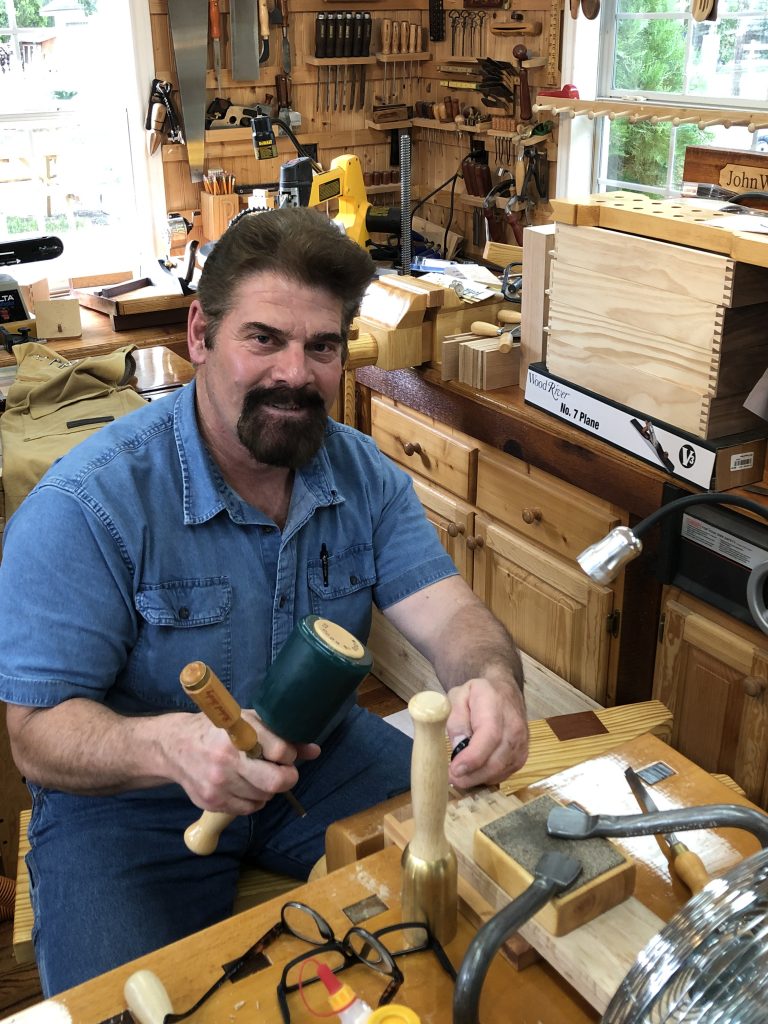
Question #1
Tobias: Hello John. Please could you tell us a bit about yourself, what is/was your career and a little about your family and how you became a woodworker.
John: I was born in 1960 and raised in upstate New York, the youngest of seven children – five boys and two girls. My father struggled to make ends meet with such a large family – he worked for General Electric for just above minimum wage. He was quite creative and innovative; if he could not afford it or borrow it, he would make it! He converted the single garage into a 20′ x 32′ workshop. My dad would teach me woodworking as we went along and, in a way, he did push me into the craft by setting me up with a hammer, nails and some boards. I made bird houses galore and will never forget that season of my life, making bird houses and feeders of every conceivable shape and size, proceeding to mount them in the trees of the forest adjacent to our home.
My dad’s shop and influence was the beginning. In high school I took woodshop which opened my eyes to the many amazing things that others had created from wood. This led me to fall in love with even the different fragrances of wood and I began to discern different species by their smell alone. The “romance” had begun…
Once I graduated from high school, I joined the U.S. Army 1982 as a combat medic and later went through the enlisted nurse course. I met and married my wife in 1986 and then as a new home owner, I was thrust, by necessity, into all sorts of home improvement and repair projects. At that time, the work would have been considered basic carpentry more than woodworking, although I was commissioned to build two twin hutches to go on each side of a fireplace. So, my “career” for 20 years from ’82 until 2002 was serving in the military, in the medical field. During those 20 years, a multitude of carpentry projects were accomplished from wall hangings, to built -in bookshelves, dry sinks, outbuildings, porch additions and firewood shelters.
My wife and I have been married for 33 years and we have been richly blessed with a son and daughter and five wonderful grandchildren!
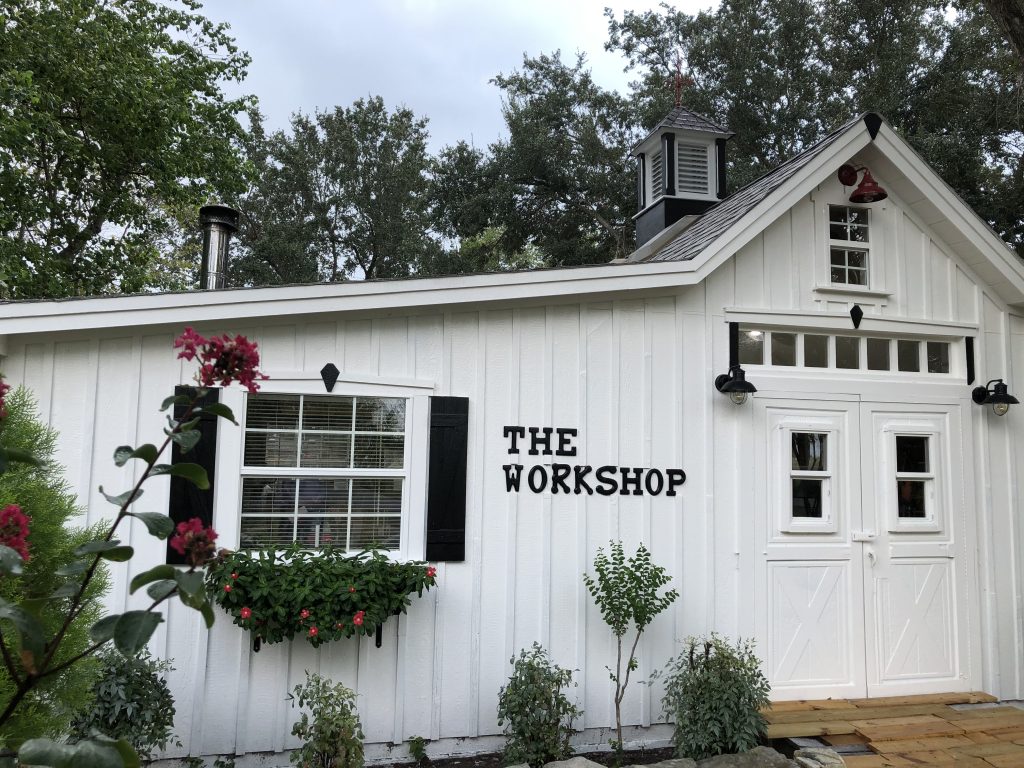
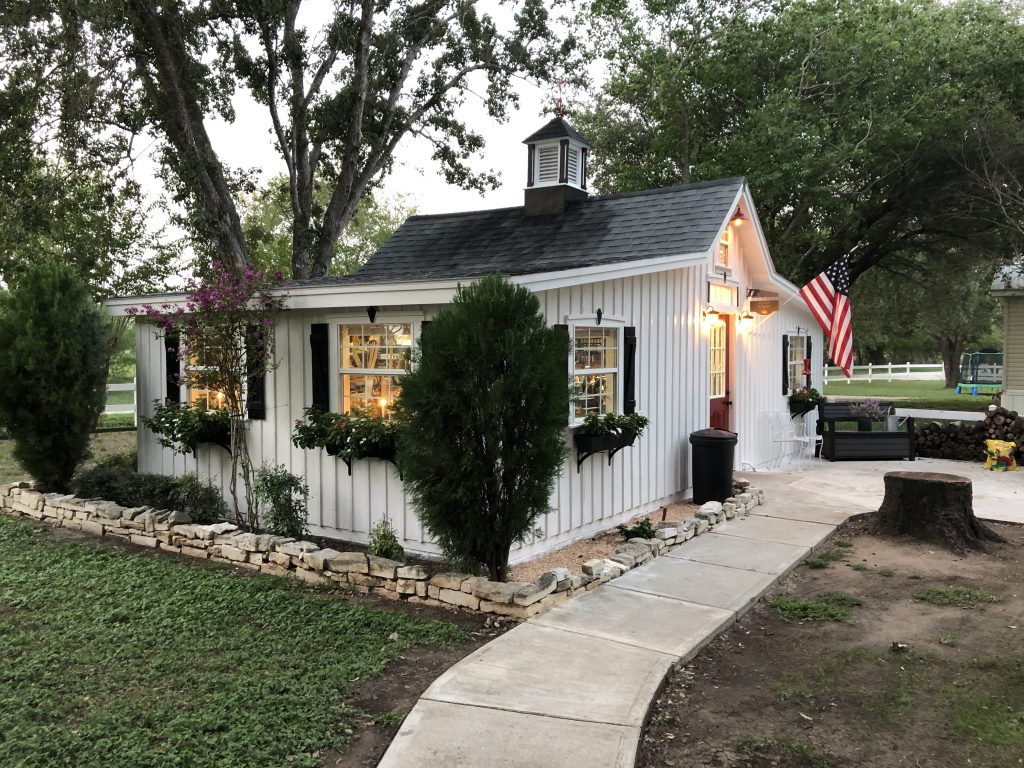
Question #2
Tobias: How did you get started doing woodwork and how long have you been a woodworker?
John: Here is where I differentiate between ‘general carpentry’ and ‘woodworking’. I have been ‘working wood’ for years, some for pleasure, some out of necessity, but work wood with any level of real acumen has been in the past 10 years or so, when my focus was sharpened. I do not recall the exact stimulus that turned my attention to traditional or historic woodworking, but it may have been the first and now several visits to the Annual Fair of the Homestead Heritage community.
In brief, they do everything the old-fashioned way and are akin to the Mennonite and Amish communities. Hundreds, perhaps thousands by now flock to their Annual Fairs where they demonstrate their traditional skills, display and sell their wares. Skills in blacksmithing, soap making, leatherwork, loom weaving, barn raising, the list is endless, but my favorite was the traditional woodworking!
Big names such as Frank Strazza and Paul Sellers teach at their wonderful Heritage School of Woodworking. Hand-cut dovetails, mortise & tenon, inlay & stringing enamored me as these disciplines were demonstrated….my heart was aflame! No power tools were used or were even present, everything was entirely handcrafted.
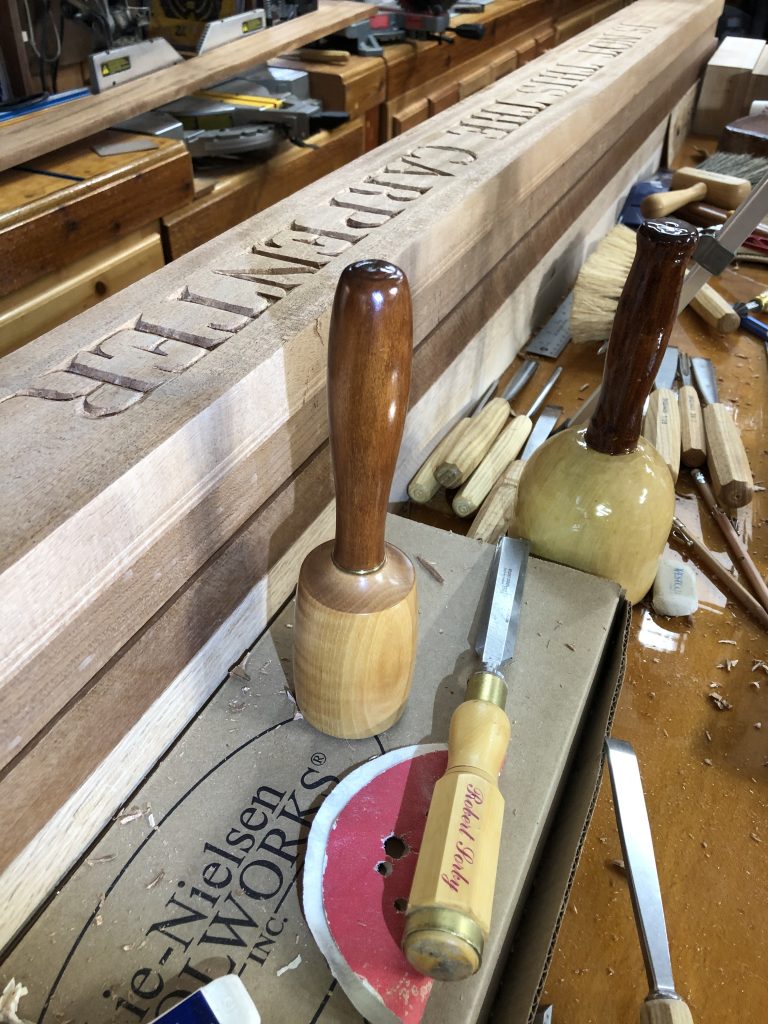
Question #3
Tobias: What was the first item you ever made and which is your favorite piece?
John: There is a ‘then’ and ‘now’ answer to this question. I made many things out of weathered Cedar and Pine, so many that I cannot recall which was the first. There were items that were intended purely as art pieces, others such as sewing boxes with multiple trays, dry sinks and cabinets and a great number of rustic barn wood picture frames. Over the past few years, some of my favorite pieces have been a trestle table with matching benches and my Shaker workbench by Benchcrafted, to which I added some personal embellishments.
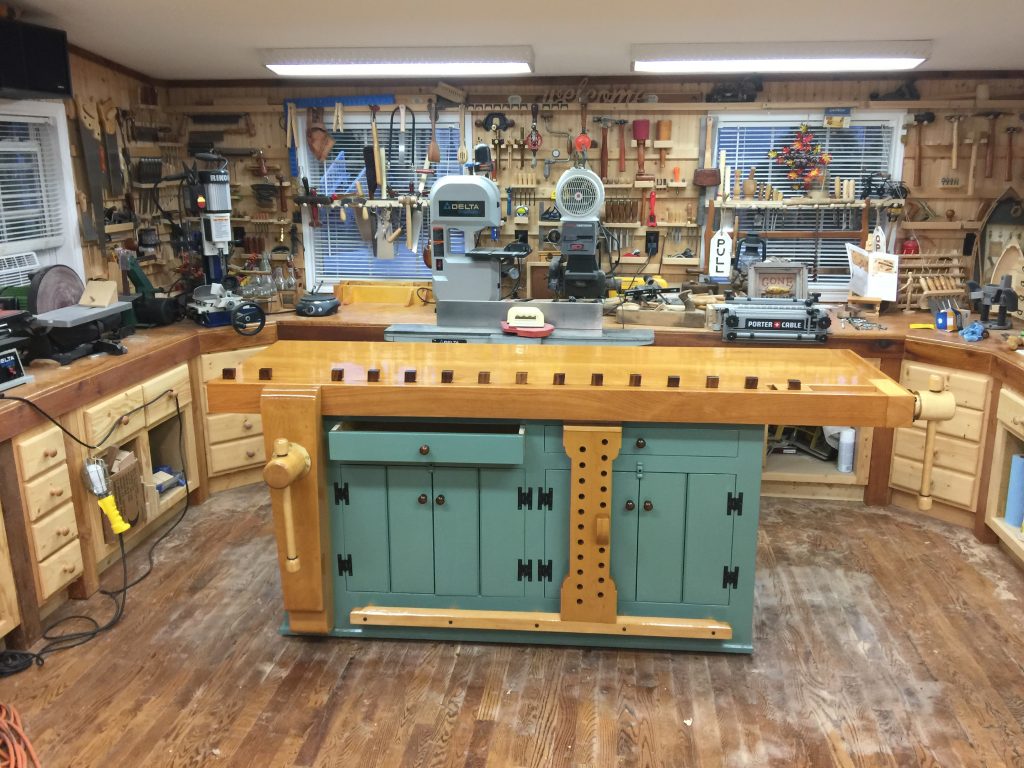
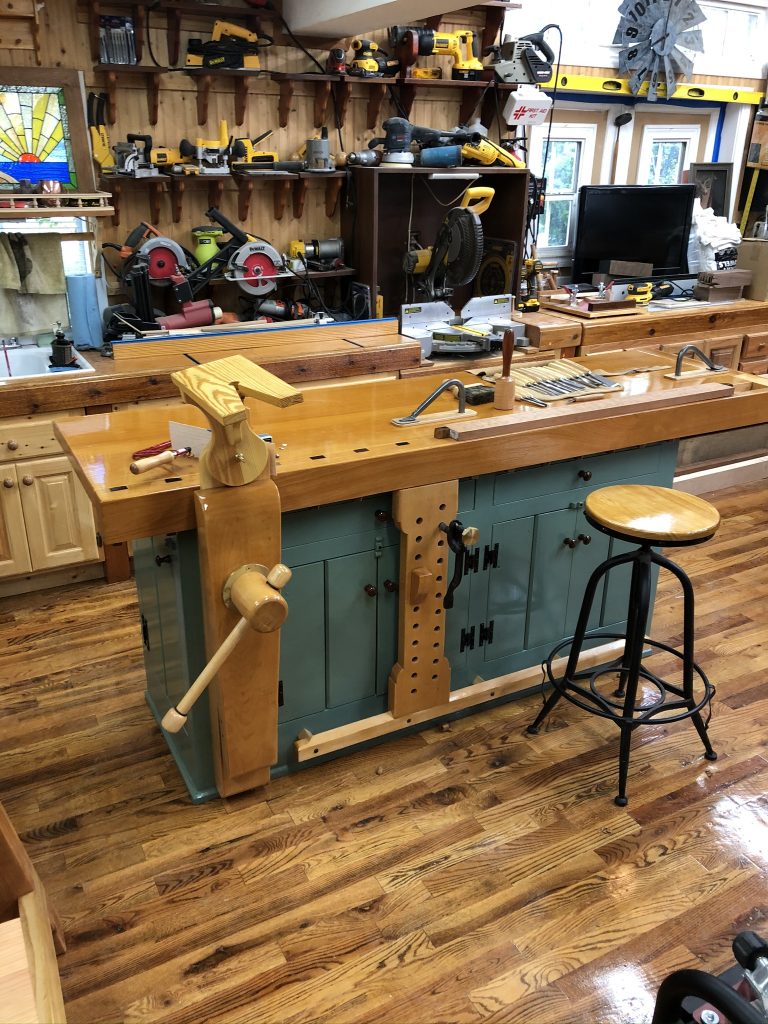
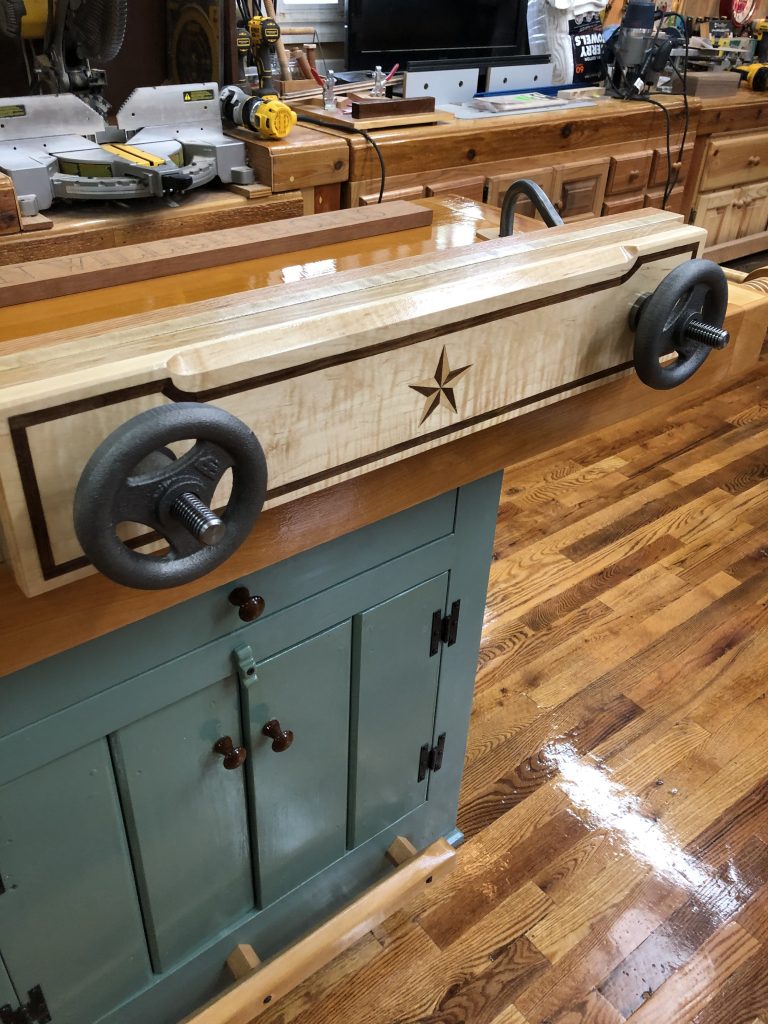
Question #4
Tobias: Which style of furniture do you enjoy building the most?
John: Shaker! The Shakers were best known for their simplicity in design. It is the quickest way for me to say it, “Shaker” would be the explanation!
It is much easier to tell you what I don’t like. I really don’t care for modern or contemporary design. I am thinking of the windy, curvy kind of work. I am not attacking it, but I tend toward more straightforward, rectilinear design.
About 10 years ago when my attention and growing passion was moving toward historic and traditional woodworking, I noticed that many traditional woodworkers were using benches that had peculiar features like a tail vise, leg vise and dog holes for bench dogs. I knew that I just had to have one of these benches, so I purchased Christopher Schwartz’s two books about how to build these historic dream benches. Watching a Youtube video put out by the Homestead Heritage School of Woodworking, wherein Frank Strazza was giving a tour of a split-top Roubo bench that he had just completed using Benchcrafted’s plans, I immediately went to their website and saw the Shaker style workbench which I was much more drawn to. I purchased the plans for the Shaker bench and commenced the most fulfilling woodwork I had done to date!
As I became more immersed in learning about woodshop furniture, fixtures and accoutrements, I made my own, from Moxon vises and shooting boards to frame saws, kerfing saws, bench hooks, registration boards and many others. I was hooked and my skill level increased with each woodshop item I made.
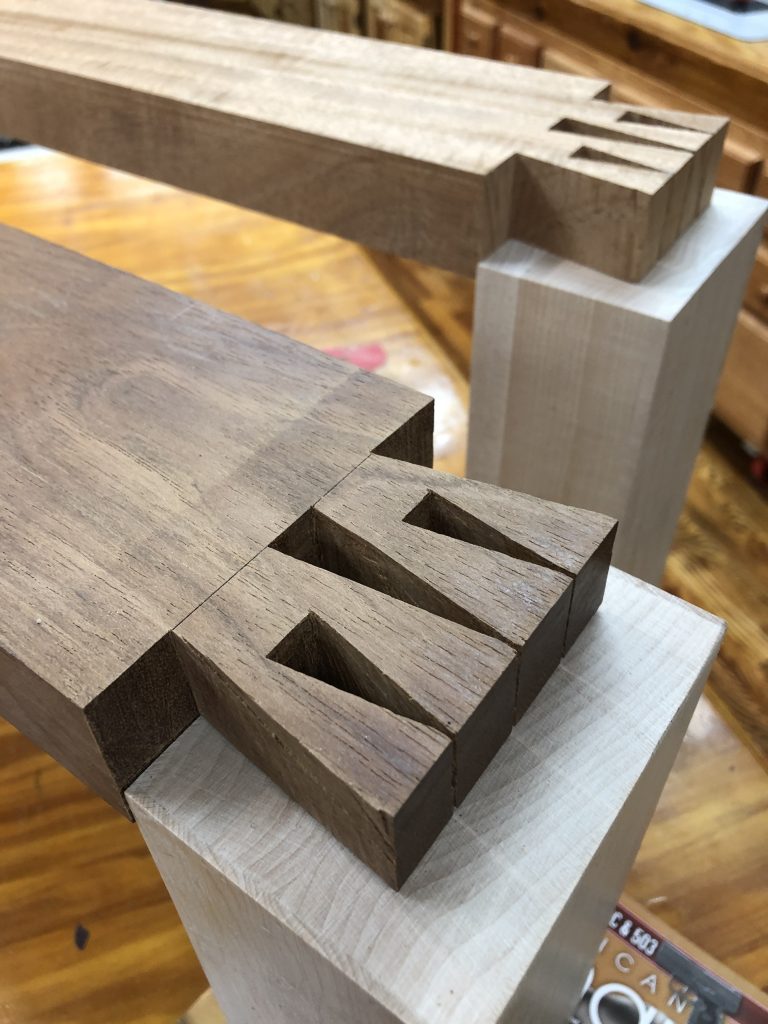
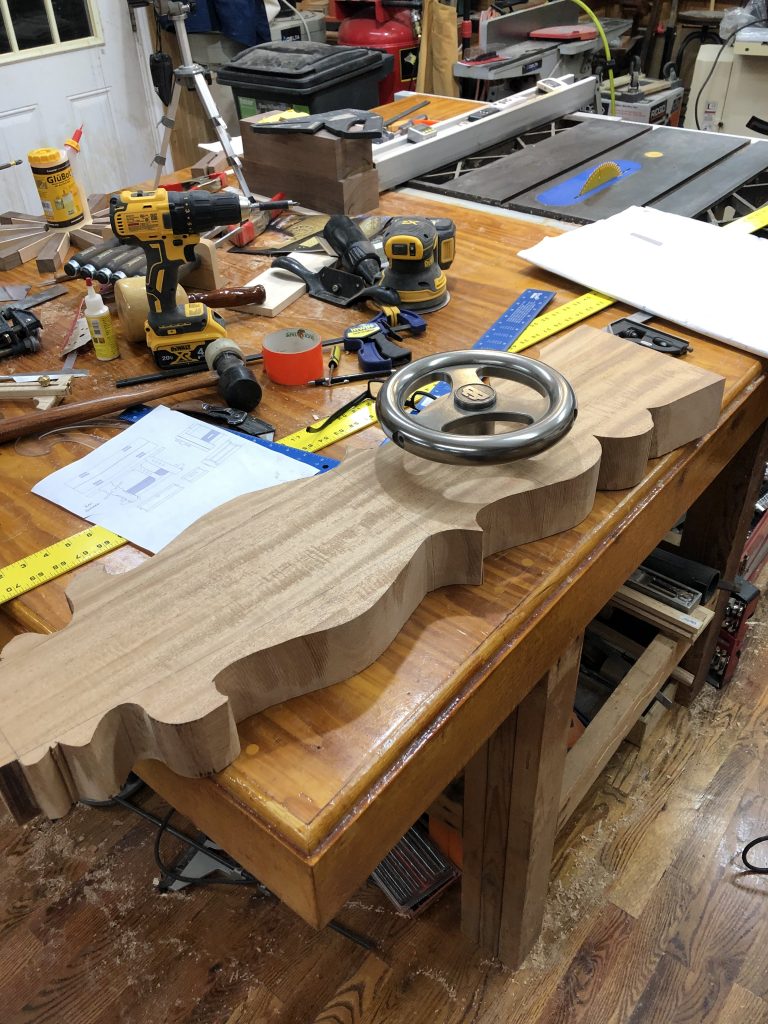
Question #5
Tobias: Which are your favorite local lumber species and which are your favorite exotics to work with?
John: I absolutely love Curly and Birdseye Maple! Also at the top of my list are Walnut, Red Oak, Beech, Mahogany, Southern Yellow Pine, White Pine (Aspen), Cedar as well as Poplar for secondary wood. I am young in faith when it comes to exotics, but am interested in trying Bubinga, Padauk, Sapele, African Mahogany and Jatoba.
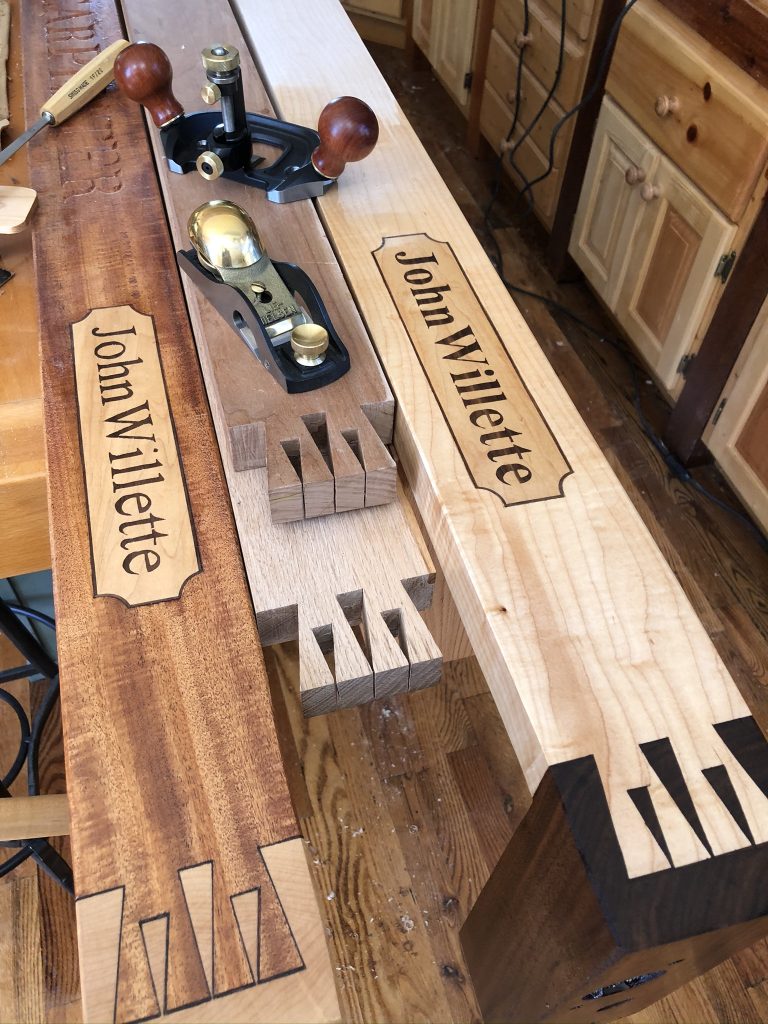
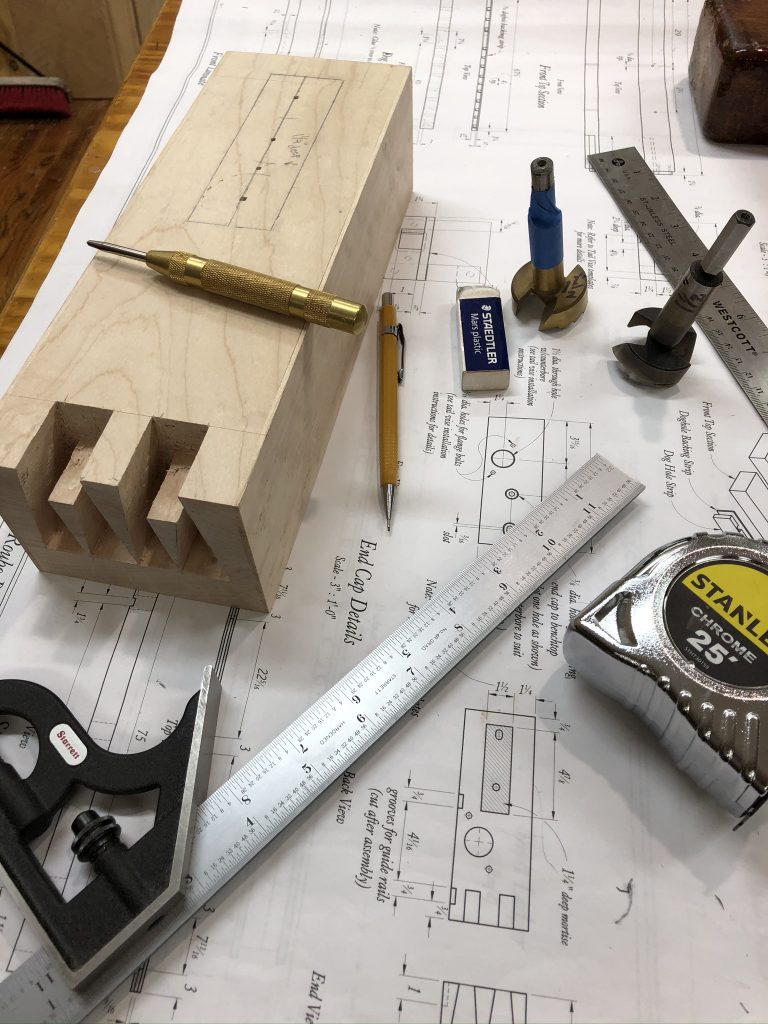
Question #6
Tobias: Please list your most used hand tools and tell us why they are your “go-to” tools.
John: Of all my hand tools, those that are involved in hand-cutting joinery are my favorites. Firstly are my chisels and mallets, closely followed by a variety of hand saws: dovetail, tenon, carcass and flushcut. My Lie-Nielsen block plane is always close at hand and I love my Lie-Nielsen #4 and #4-1/2 smoothers, but I do confess that I have not yet truly mastered hand planes to date. I set aside days exclusively devoted to skills practice: sharpening, sawing, planing, dovetails, brace and bit, they all need regular practice!
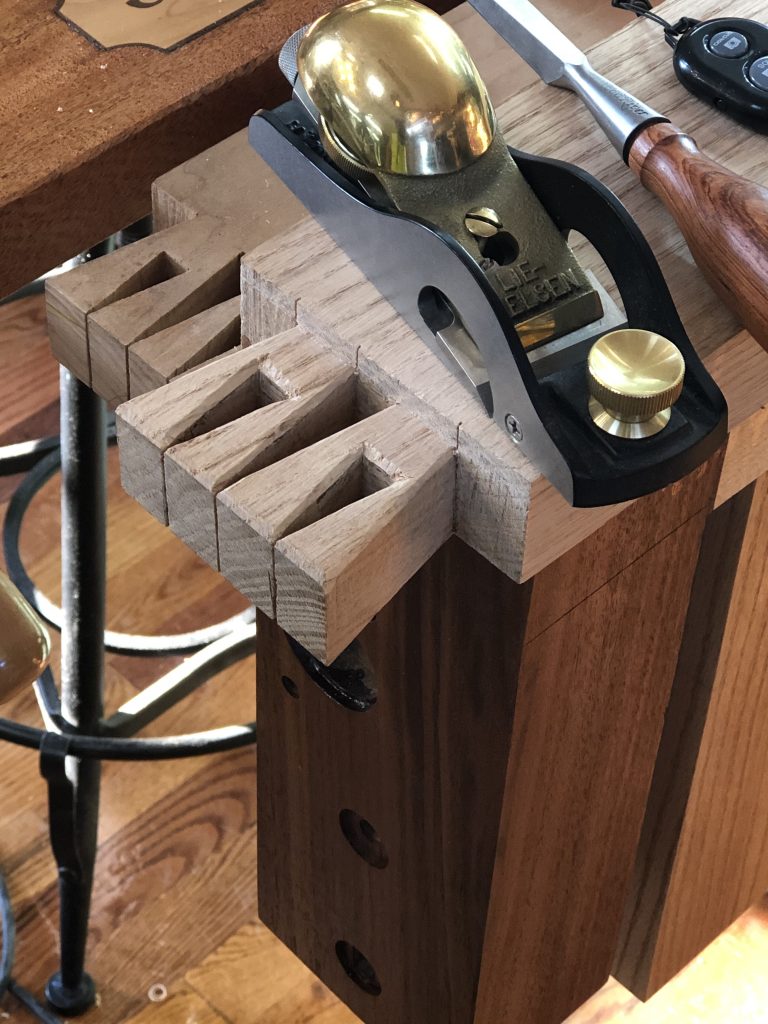
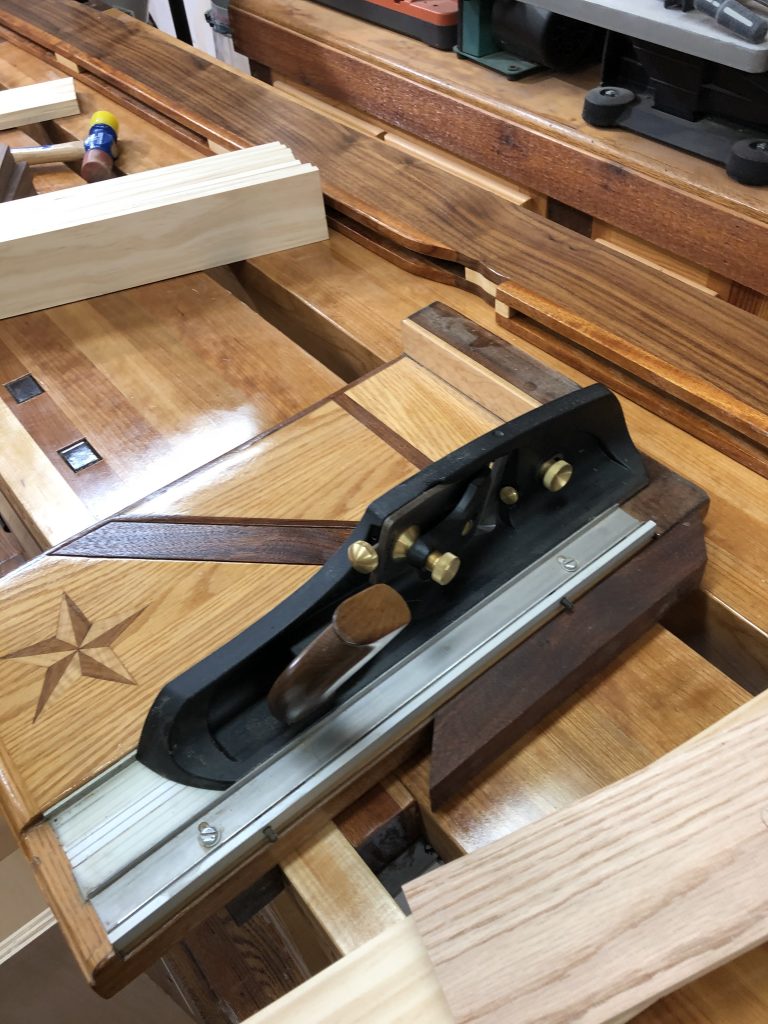
Question #7
Tobias: Can you list your favorite power tools and machines and tell us why?
John: My new 3HP Shopfox W1820 would head the list by far. It is a superb machine for ripping stock to width! I say ‘new’, because my Sears Craftsman table saw finally gave up the ghost after 33 years of faithful service. ( I know it was 33 years, because I purchased it the same year my wife and I were married). I also purchased my Craftsman radial arm saw that day and it’s still going strong and I incorporated it into my long bench like my dad had done.
The double compound miter saw is excellent for bringing rough stock to length and I wouldn’t be without it. Along with the above machines, the bandsaw, 13″ benchtop planer and drill press are also indispensable in the shop and complete my arsenal.
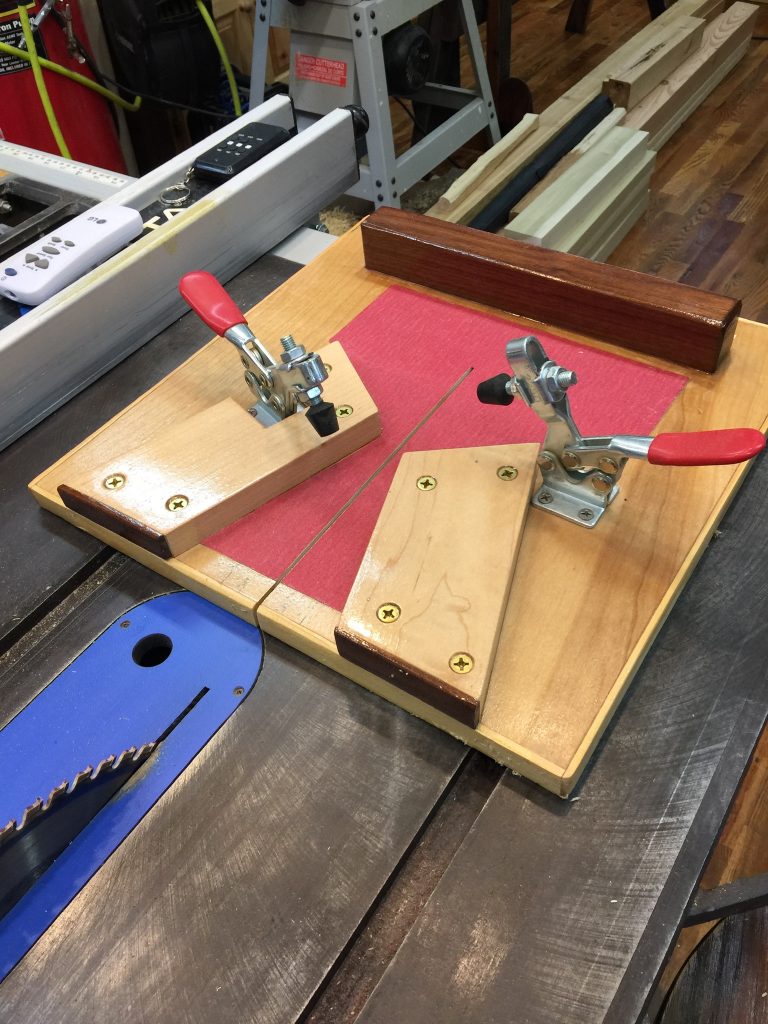
Question #8
Tobias: What is it about working with wood that you find most enjoyable?
John: The way that the various species stand out or ‘pop’ when they are moistened with an oil or other type of finish, is extremely exciting. I even like the fragrance of different species emitted when the wood is sawn. To me there is a natural beauty and warmth in honest solid wood versus items made from composite or synthetic materials.
In my opinion, there is nothing that can substitute of duplicate the look and feel of real wood.
I really enjoy the long history and antiquity of woodworking, woodworkers and the traditions of all things carpentry, they have endured the test of time. Any type of meaningful activity, of necessity will engage our minds and well as our hands, but crafting with your own two hands is significant in that it stand head and shoulders above the mundane. The very word ‘handcrafted’ has edification to to it!
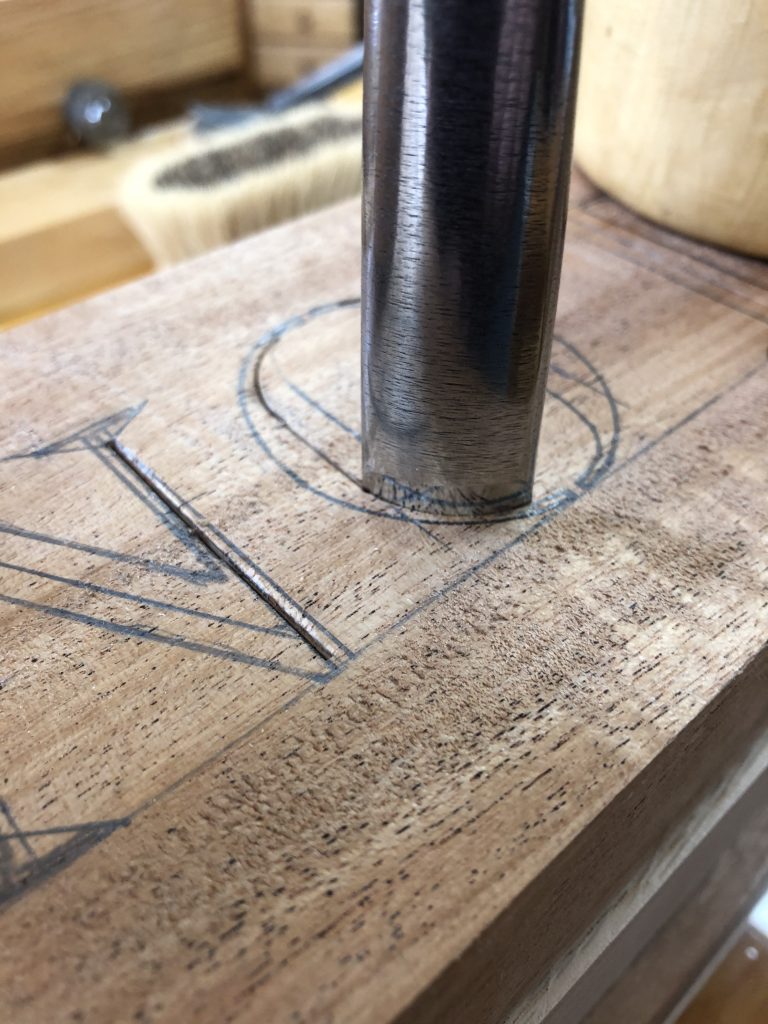
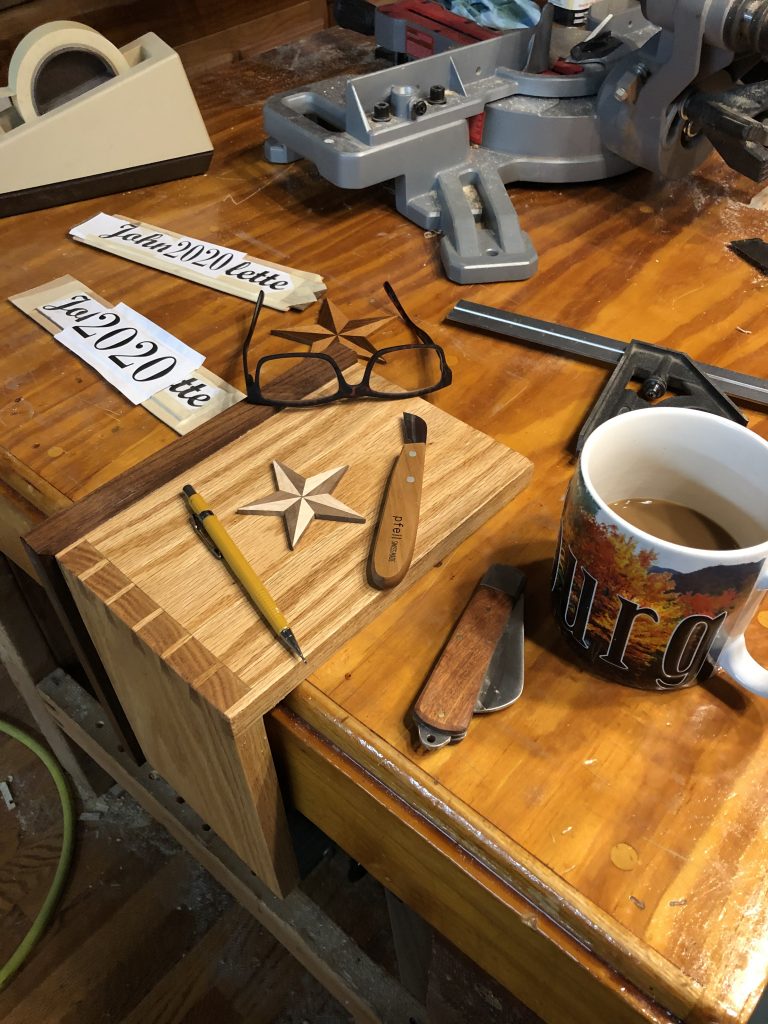
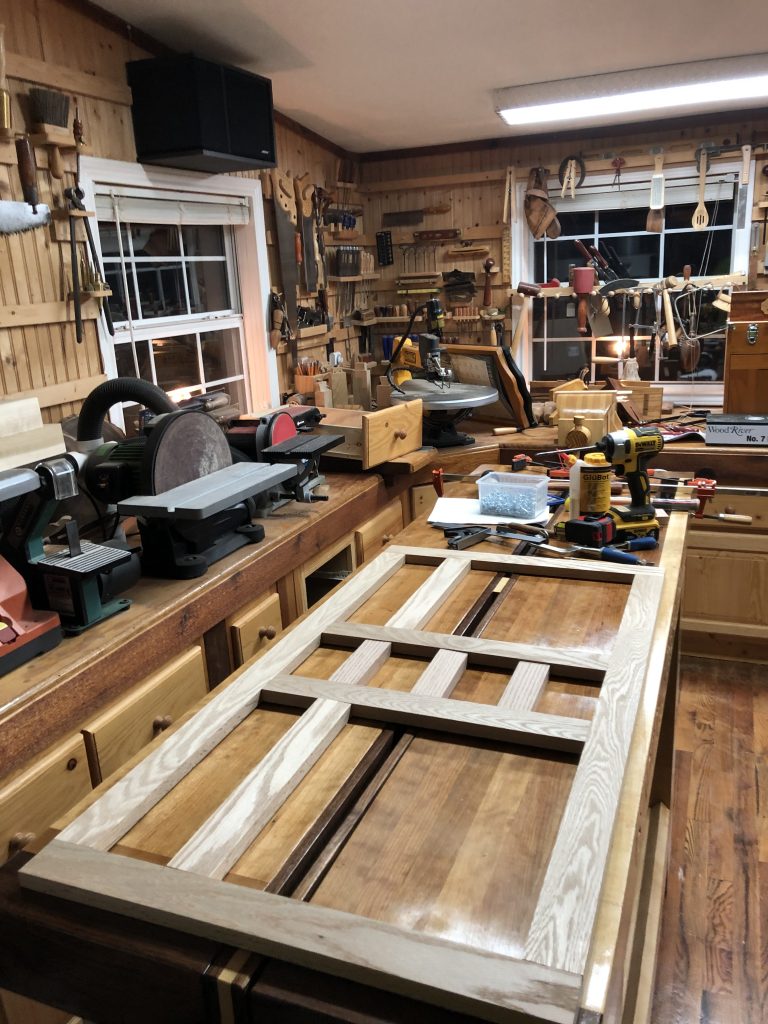
Question #9
Tobias: What type of workshop do you have, how has it evolved over time and why?
John: I have been really looking forward to answering this question, as I have poured my all into creating my workshop with blood, sweat and tears over the years.
The best distinction that I have heard others use in reference to “type of workshop’ , is between a hobby and a production shop.
A production shop would imply that your livelihood depends on it, whereas a hobby shop is where you create for pure pleasure and gratification. At this stage of my life, my workshop falls into the latter category. I was paid for furniture pieces that I made for others, earlier on. Now that life and craft have evolved, my workshop is in constant evolution.
The shop is a detached building adjacent to the home and started out as a small outbuilding 12′ wide by 16′ long. While in the military, we were always moving round every three years and there was never an opportunity to set up any form of comprehensive workshop of the size that I desired.
When we moved to our present home, there were no outbuildings at all. The property was large enough to accommodate whatever size building I wanted, however I was in a hurry to have a place and space in a more immediate timeframe. So I purchased two buildings, one (8′ x 10′) to serve as the garden shed and the largest outbuilding that could be transported became my instant workshop!
Some changes resulted in another 10′ addition on either side of the shop, giving me the present dimensions of 16′ x 32′ and plans are in the works for further expansion!
My workshop is very much an extension of my character and personality, both inside and out. I could describe myself as old-fashioned, nostalgic, loving words like vintage, antiquity, patina, weathered, wholesome and good old days. I enjoy interior decorating and exterior New England architecture. From the beginning, I wanted the shop to be attractive with a warm, vintage, old-timey look and ambience. I feel that one’s work environment has a direct impact on one’s work. If a man loves his environment, he will feel great liberty in his work.
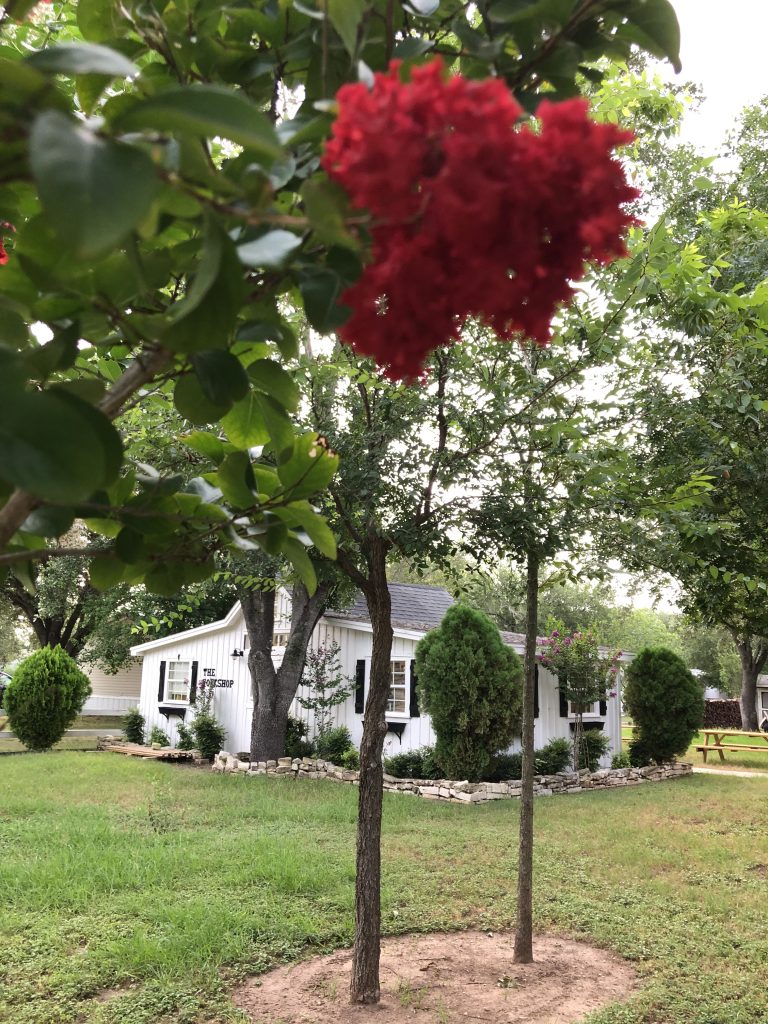
QUESTION #10
Tobias: What is your clamp line-up and why?
John: Most woodworkers have heard the oft repeated phrase, “you can never have enough clamps”… I took this seriously when setting up the shop and devoted one entire wall to my clamps. I built an array of mounts, racks, hooks rods and supports to mount my clamps.
The range includes C-clamps, F-clamps, pinch clamps, pistol grip clamps, wooden hand screws, bar clamps, band clamps and ratchet clamps. Almost all of the clamp types include large, medium and small varieties across the spectrum as there in no single clamp that has a universal application.
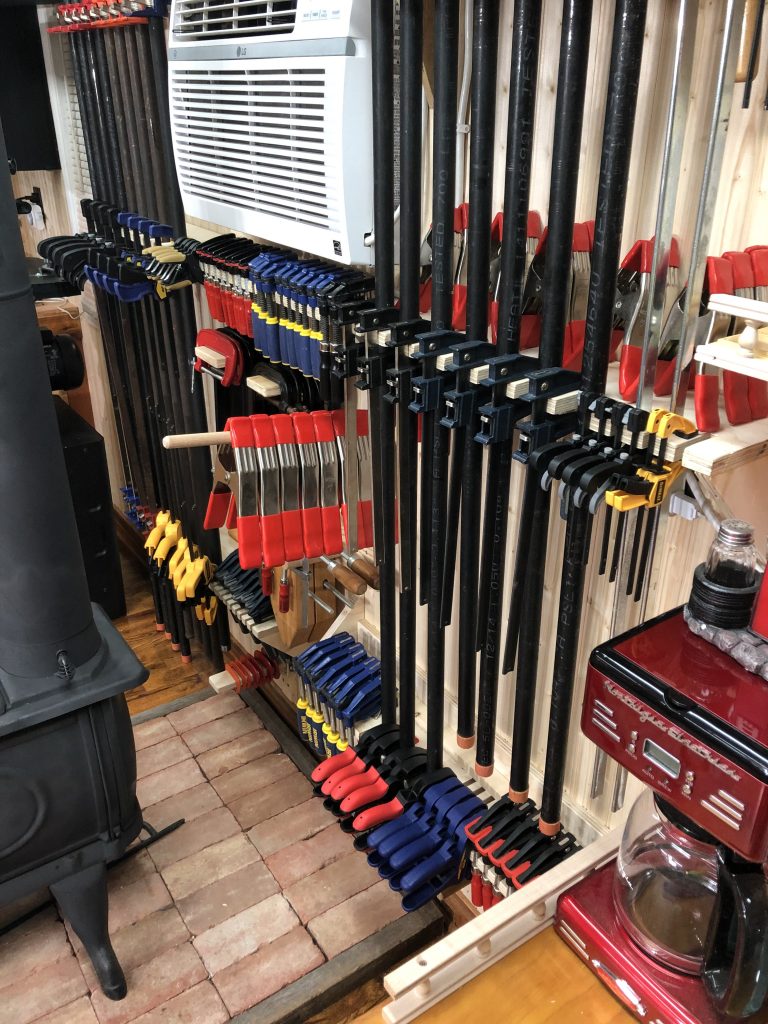
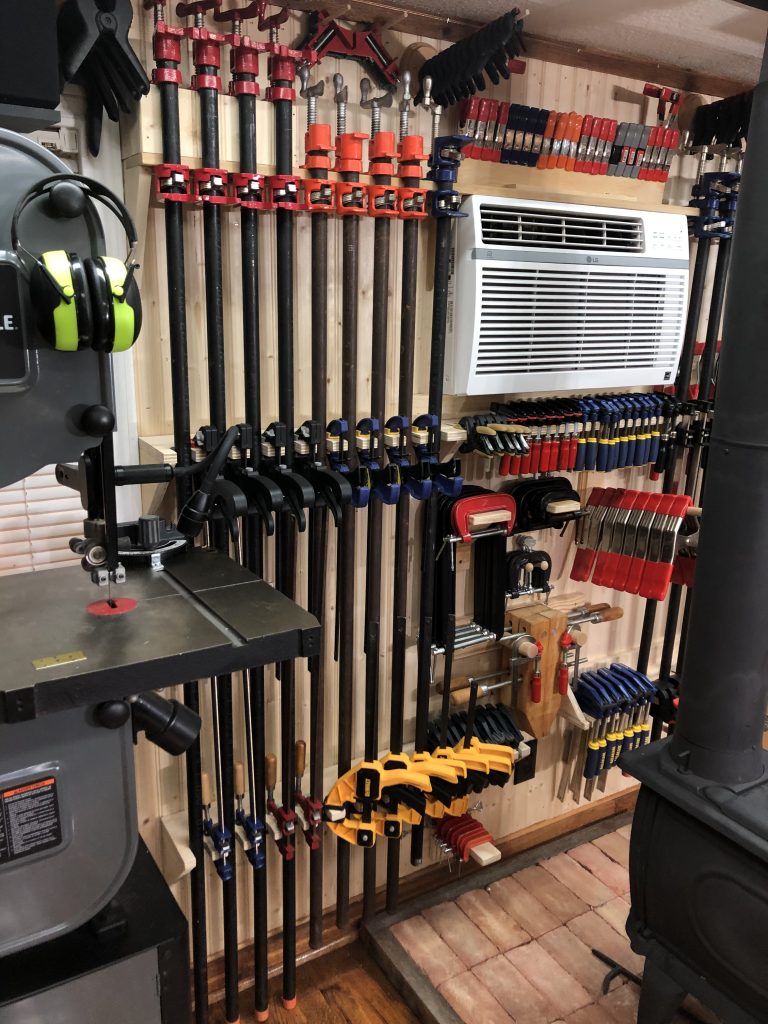
Question #11
Tobias: Which adhesives and glues do you use and why?
John: I generally use yellow glue, from Elmer’s to the various versions of the Titebond brand. On the little double-bevel marquetry and inlay work that I have done, I have used hide glue. Although hide glue can be bought ready-made in gel form, I prefer to mix my hide glue from scratch and have set up a dedicated hide glue station with a vintage cast iron double glue pot. I use 192 gram strength granular hide glue and incorporate a small quantity of urea to extend the open time of the hot glue. This is all part of my quest (as much as is practical and possible) to return to the “Old Ways of Working Wood”!
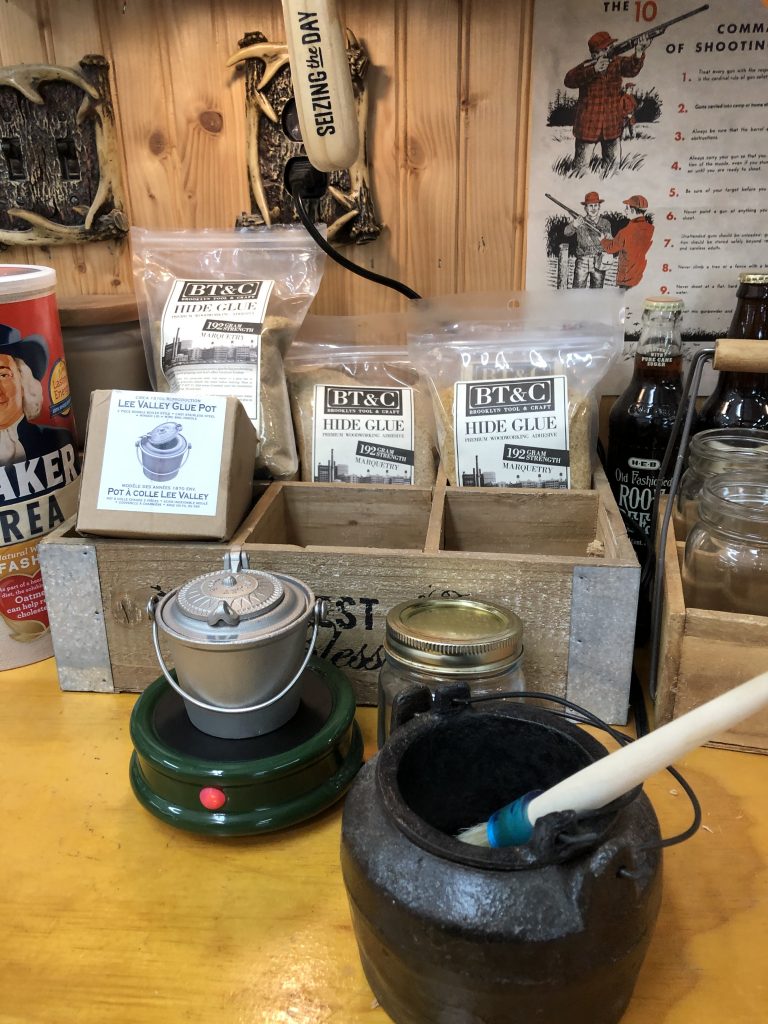
Question #12
Tobias: Which woods (exotic and local) have you not yet used and why are you interested in building with these species?
John: There are many exotic woods that I have admired from a distance, but have not yet used.
There are some that I reasoned that only be used for certain applications, for example Purpleheart or Zebrawood. I ask myself how I could I use these woods for their natural beauty, color and figure. When I try to answer this question, I come to the conclusion that some species have limited or specific applications. I would love to build a piece featuring woods such as Padauk or Bubinga as I really adore their color and grain.
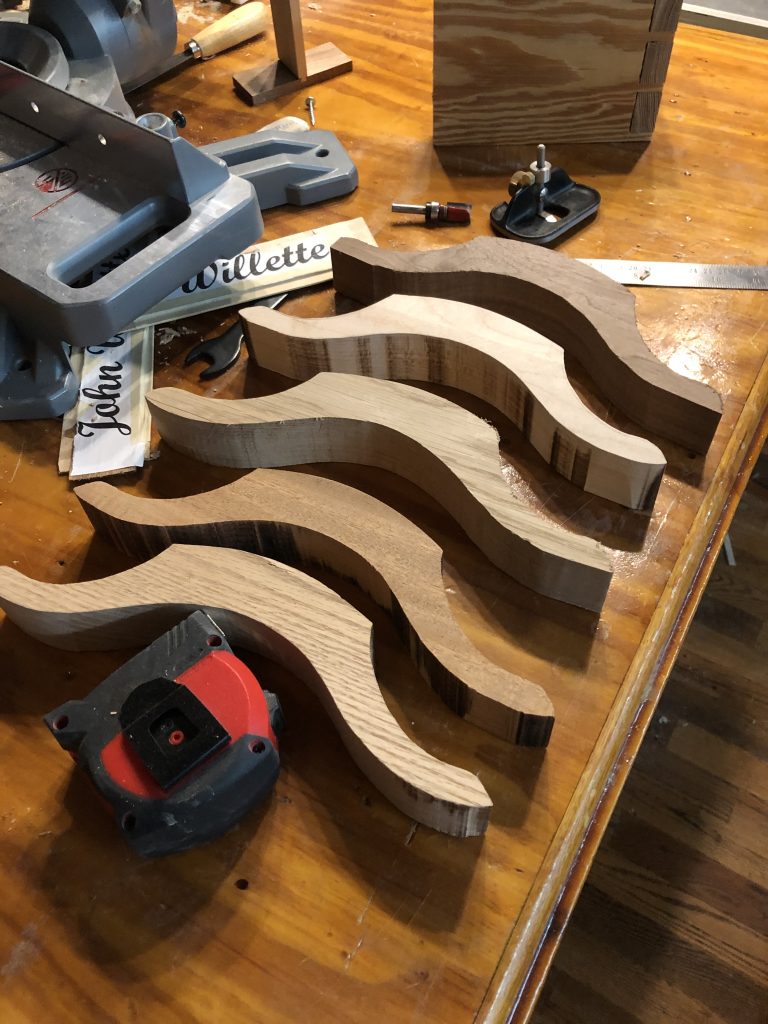
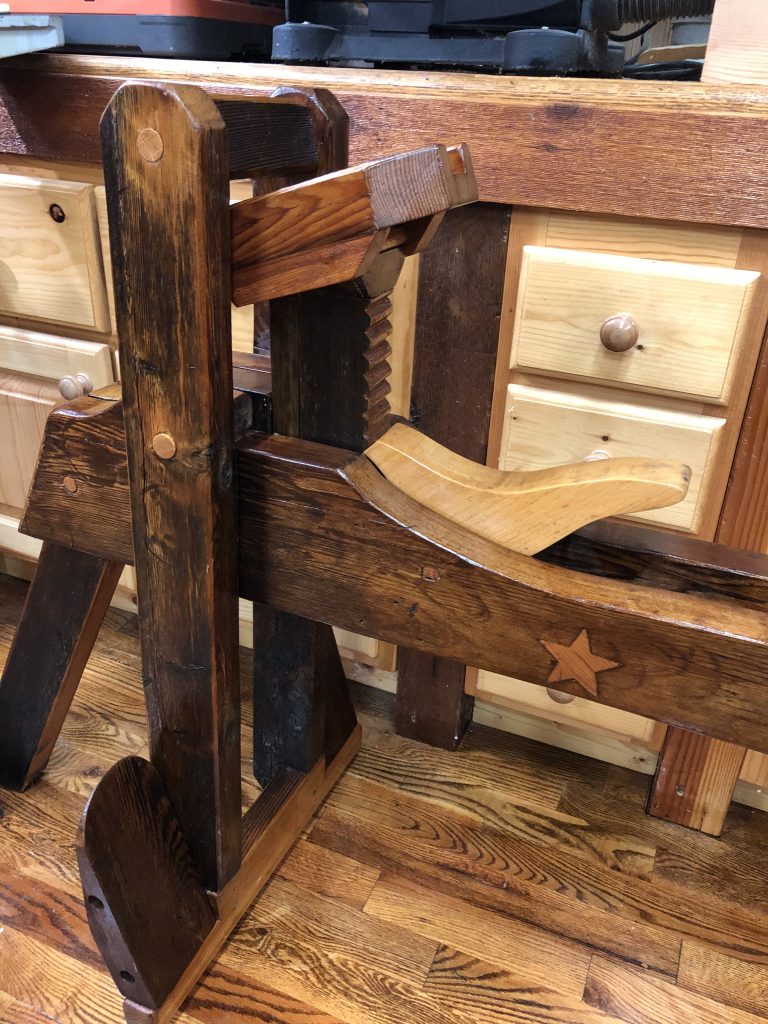
Question #13
Tobias: What and whom are your sources of inspiration for your craft?
John: It depends entirely on which aspect of my “craft” we would be considering. If it had to do with a Windsor chair, my first choice would be Curtis Buchanan and then Greg Pennington and Elia Bizzarri.
Initially, a great deal of my inspiration came from watching, learning and being motivated by Youtube videos. This opened a whole new world of woodworking for me, again with emphasis on old style, traditional and historic woodworking.
About 8-10 years ago, I started watching a young man called Matthias Wandel, who struck me as a simple and humble fellow with superior intellect and exceptional talent. I was dumbfounded as to what he and his dad made from wood, but what really won me over was when he did a tour of his dad’s workshop. I was as if we had stepped back in time to an earlier era. I drew a lot of my design ideas and “feelings” from his dad’s shop for my own. I was absolutely mesmerized by the whole array of wooden door latches, knobs, handles, slides and even wooden hinges that Matthias’ father had made.
So, my Youtube “heroes” definitely include Matthias and his buddy John Heisz. For sheer craftsmanship in traditional joinery, I turn to Jesse de Geest (aka The Samurai Carpenter). If I am in the mood for some wit and comedy coupled with good instruction, Stumpy Nubs (James Hamilton) is always worth watching.
When I need inspiration for traditional and historic workbenches, period hand tools and techniques, I turn to Christopher Schwarz and books by Alex Bealer and of course, Aldren A. Watson – “Hand Tools, Their Ways and Workings” which is an incredible work. A similar task was accomplished by Peter Galbert in his coveted “Chairmaker’s Notebook”.
Others I follow closely are Frank Klausz, Garrett Hack, Paul Sellers and Frank Strazza.
Without doubt, Frank Strazza has been the most influential on my growth as a woodworker, partly because we live in close proximity. Frank has been a wonderful role model and mentor for me in my traditional woodworking development and I will be eternally grateful to him for his enthusiasm, advice, knowledge and friendship.
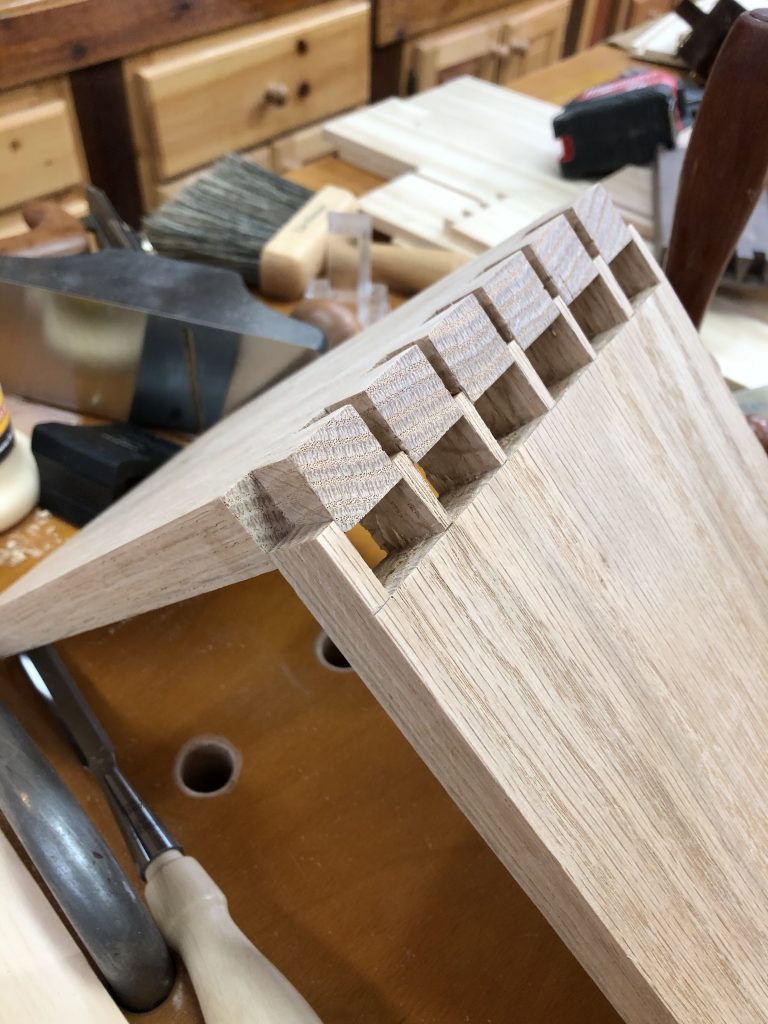
Question #14
Tobias: How do you design your pieces? Do you use CAD or SketchUp? Do you sketch out by hand?
John: I am not adept with SketchUp and I don’t work with CAD. I am rather envious of those who are, like my son-in-law who tells me that he sees things in 3D. I tend to formulate ideas in my head over time and then I put pencil to paper to work out the finer mechanics and details of a concept.
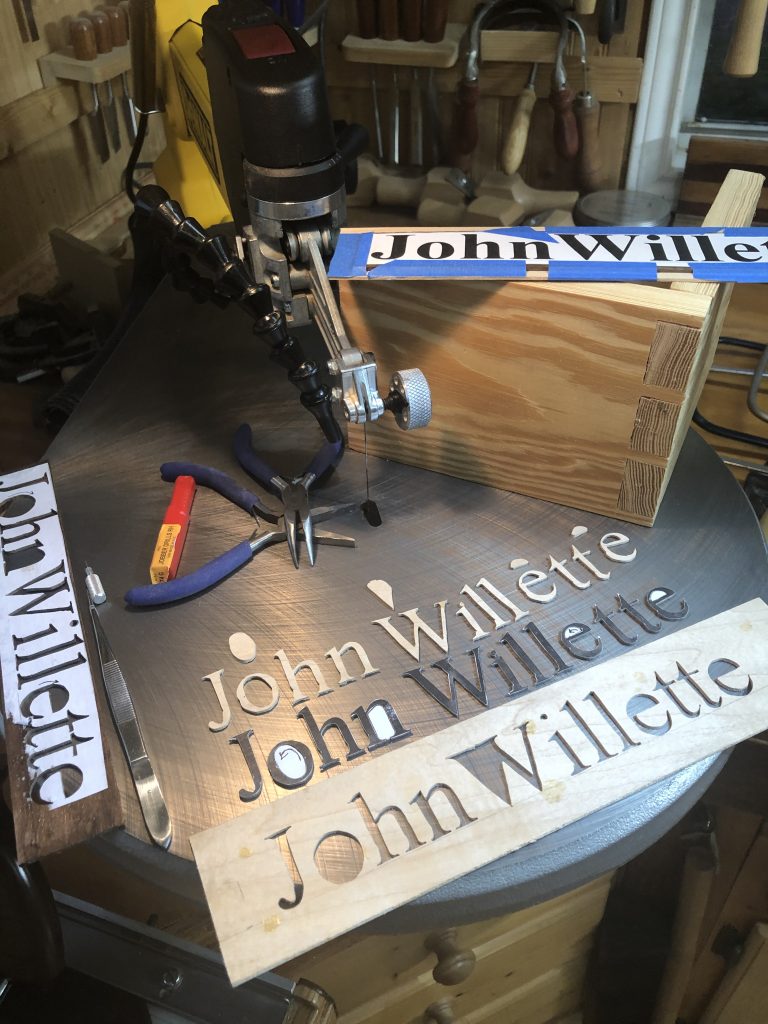
Question #15
Tobias: What are your finishing regimes, what products do you use and which are your favorite processes?
John: My finishing department contains every finish I know of, with the exception of shellac flakes. I like to have a very wide array of options at my disposal for experimenting and judging my finishes.
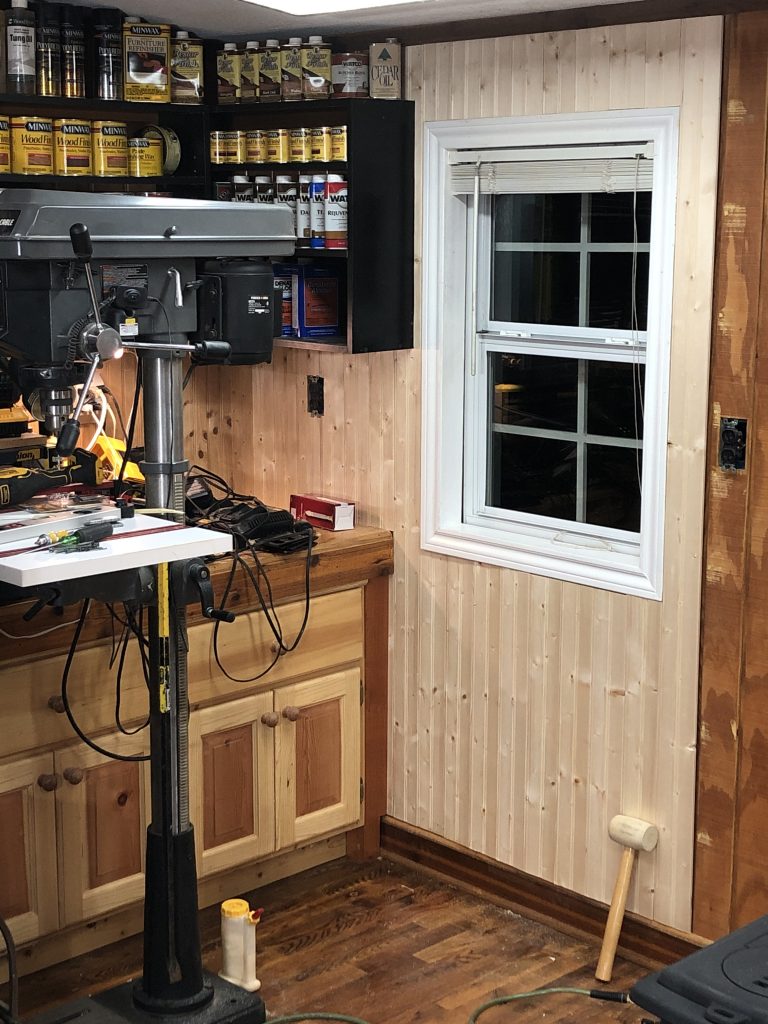
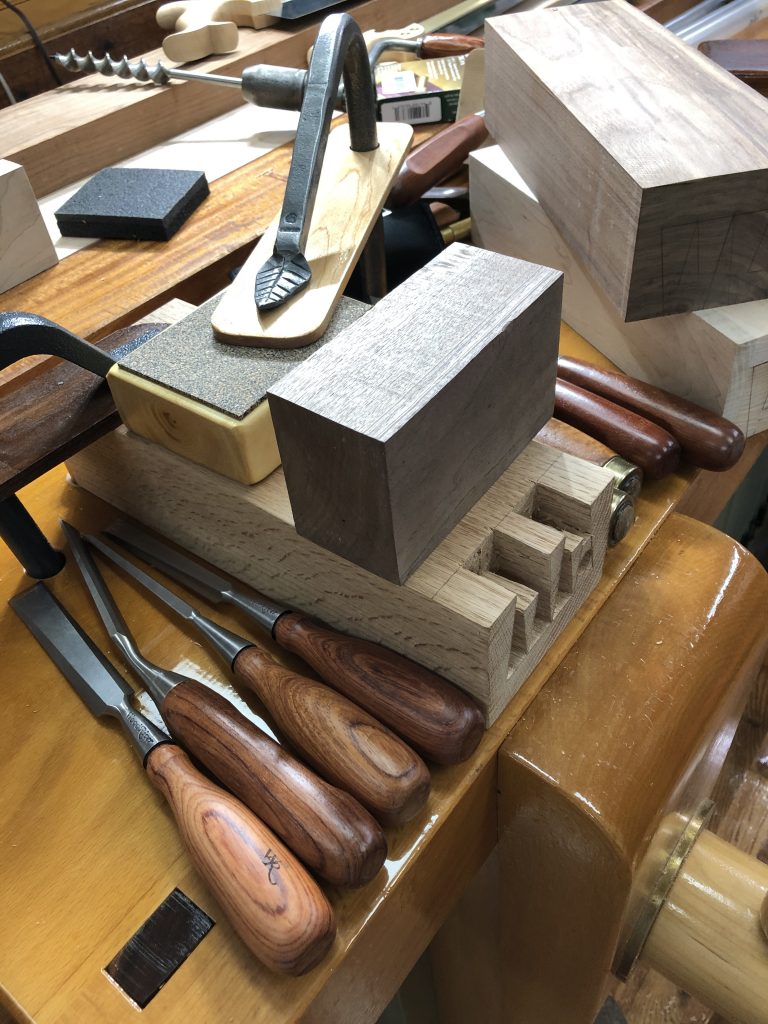
Question #16
Tobias: Which parts of working with wood do you dislike the most?
John: This is a difficult question because there is not much about woodworking that I don’t enjoy.
I think that dust collection and keeping my shop in order rank highly. Invariably there will be sawdust in our shops, settling on everything. I have spent a great deal of time, money and research on dust collection and I am still not satisfied, even though I have dedicated extraction at each workstation and a central ambient air cleaner hanging from the ceiling.
I guess that it is part of our nature not to stop periodically and put tools away and re-find the top of our workbenches! It is important to stop and regroup regularly to sweep and clean. I dislike splinters, some glue-up processes and not being able to source a specific species of wood. I do’t enjoy replacing blades and tuning up machines at all, but I am sure that this is not unique only to me.
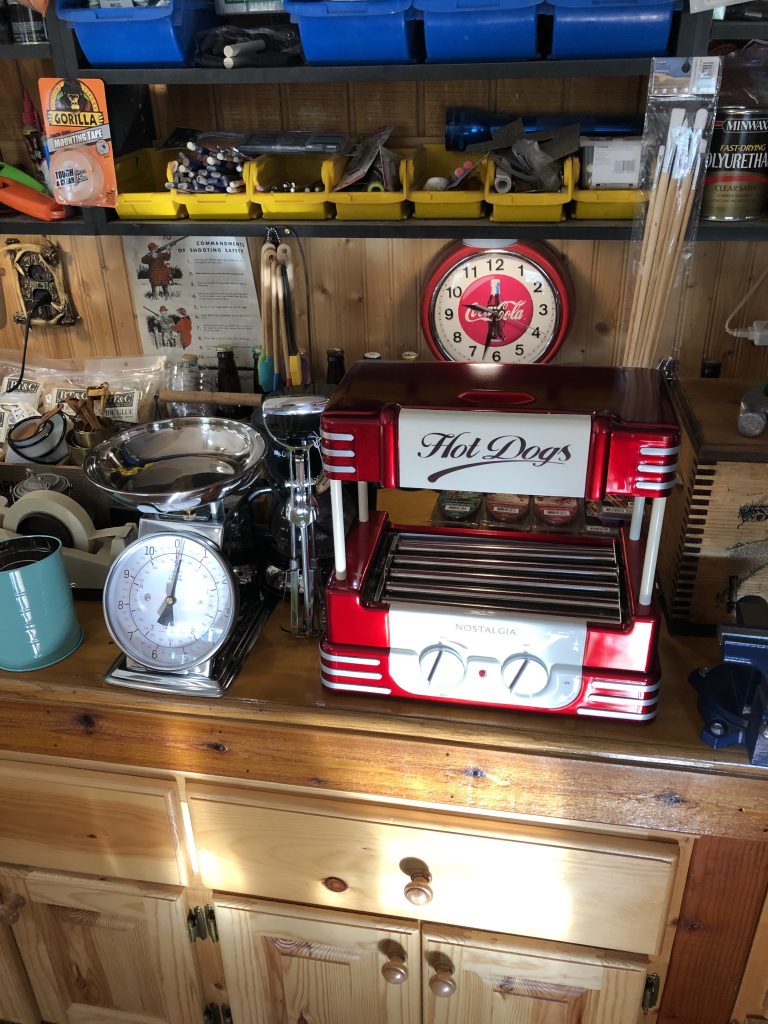
Question #17
Tobias: What is your favorite music to listen to whilst working in your shop?
John: This is a fun question. Workshop music can’t be distracting, but rather needs to be facilitating. Classical music could be heard for years in my shop, but not all classical music is soothing. I listen to a Youtube “happy music” channel from time to time when I am a bit depressed. I love classical guitar and listen to a talented chap called Snodgrass. I don’t only listen to music in my shop, often I listen to expository sermons by profound teachers, speakers and preachers.
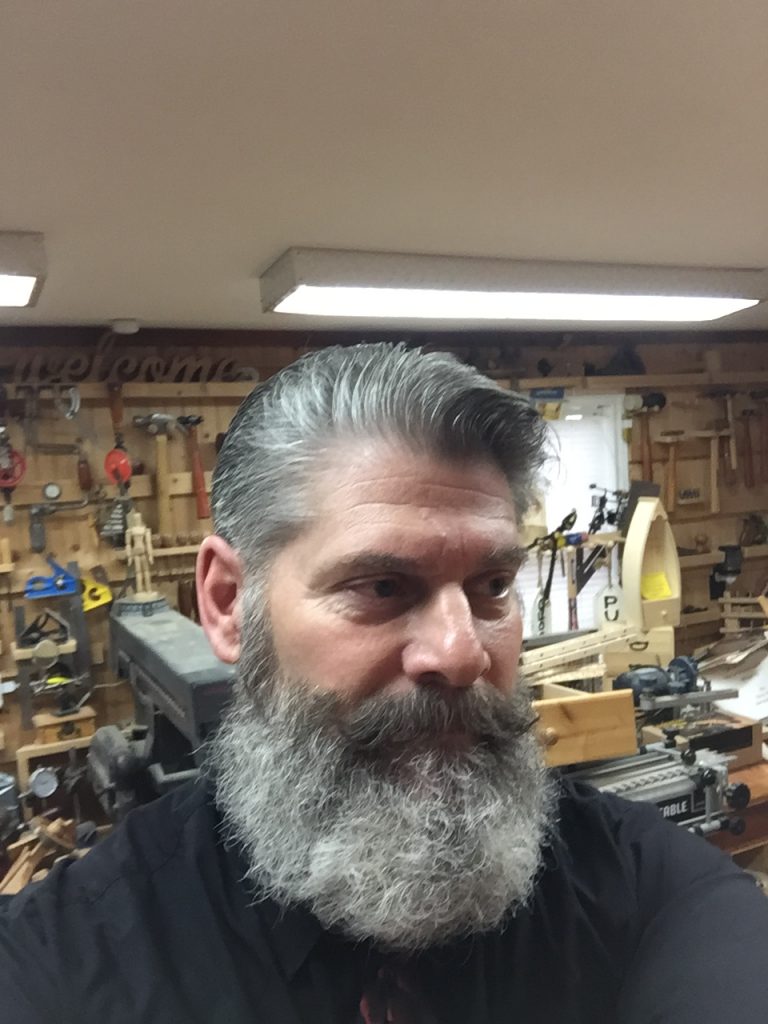
Question #18
Tobias: What is you tool sharpening regime?
John: I arrived at my system due to the influence of three men. I have set up my sharpening stations like theirs, use the stones they use and techniques they teach. Steve Branam touts oil or waterstones. The other two, Paul Sellers and Frank Strazza love diamond stones.
My sharpening workstation contain most of the aids, jigs and honing guides that I require, whether I am sharpening chisels, plane irons, scraper blades, card scrapers or the teeth on my hand saws.
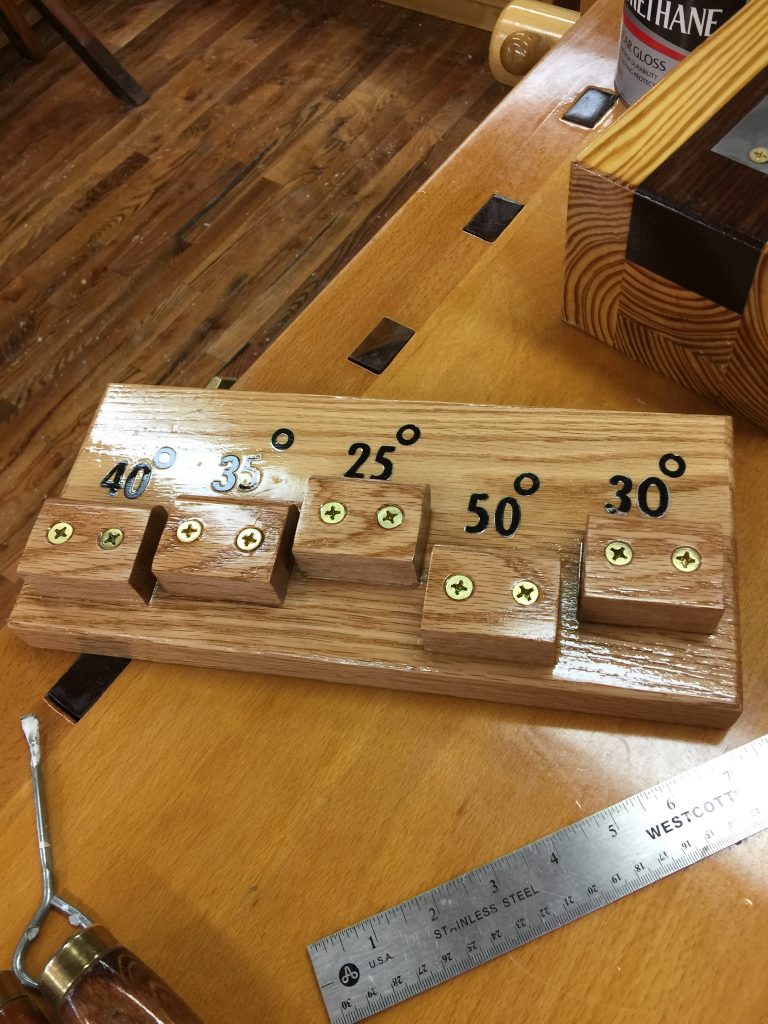
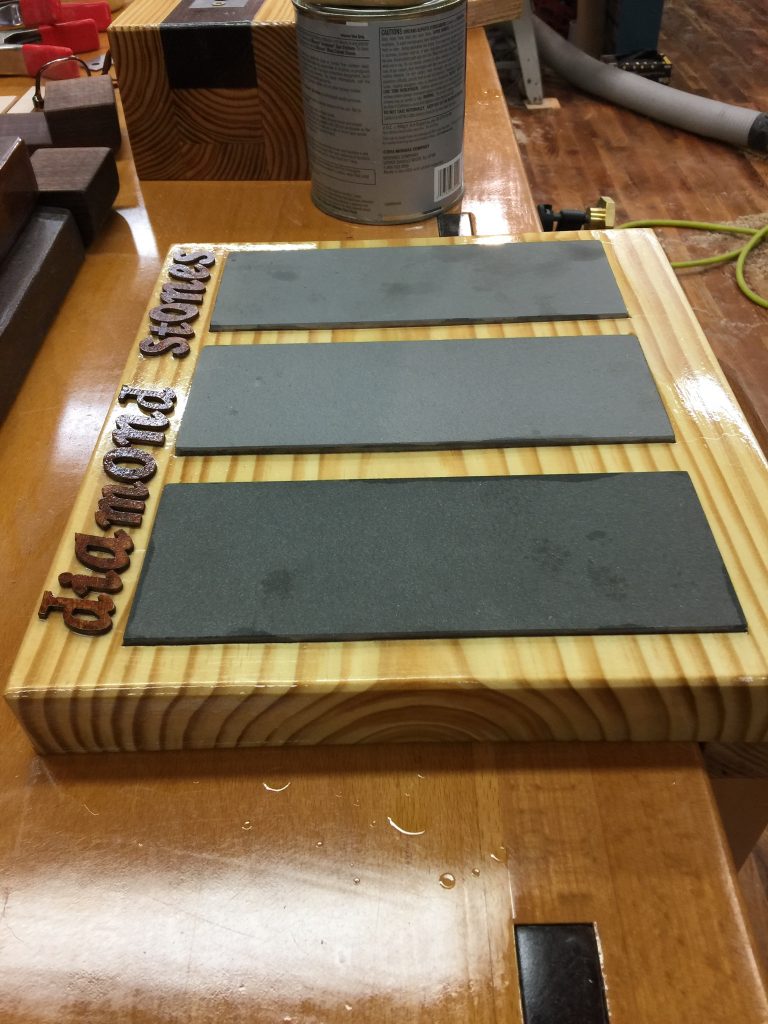
Question #19
Tobias: What custom jigs or tools have you developed for your woodworking?
John: I have built several aids, devices and tools that make my builds faster and often, easier. I suppose that some of the items could be classified as ‘shop furniture’. I have made a sled jig for cutting star facets, inlay jigs, plane iron registration jigs, two pairs of winding sticks, narrow and wide bench hooks, planing stops for both thick and thin boards, a dovetail registration/alignment jig, a wooden wheel chamfering jig, a kerfing saw to go with my Roubo frame saw, stationary and swivel bird’s mouth fretwork boards for marquetry, a slotted drawer frame sanding board, wooden bench vise, Moxon vise and vintage style workbench.
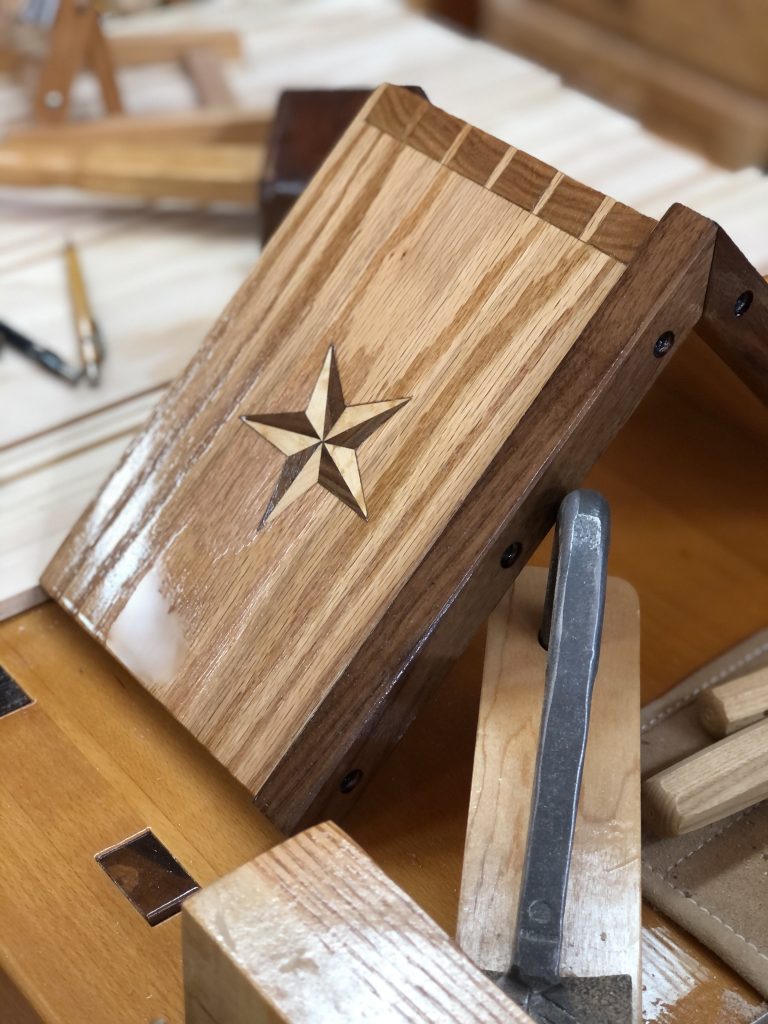
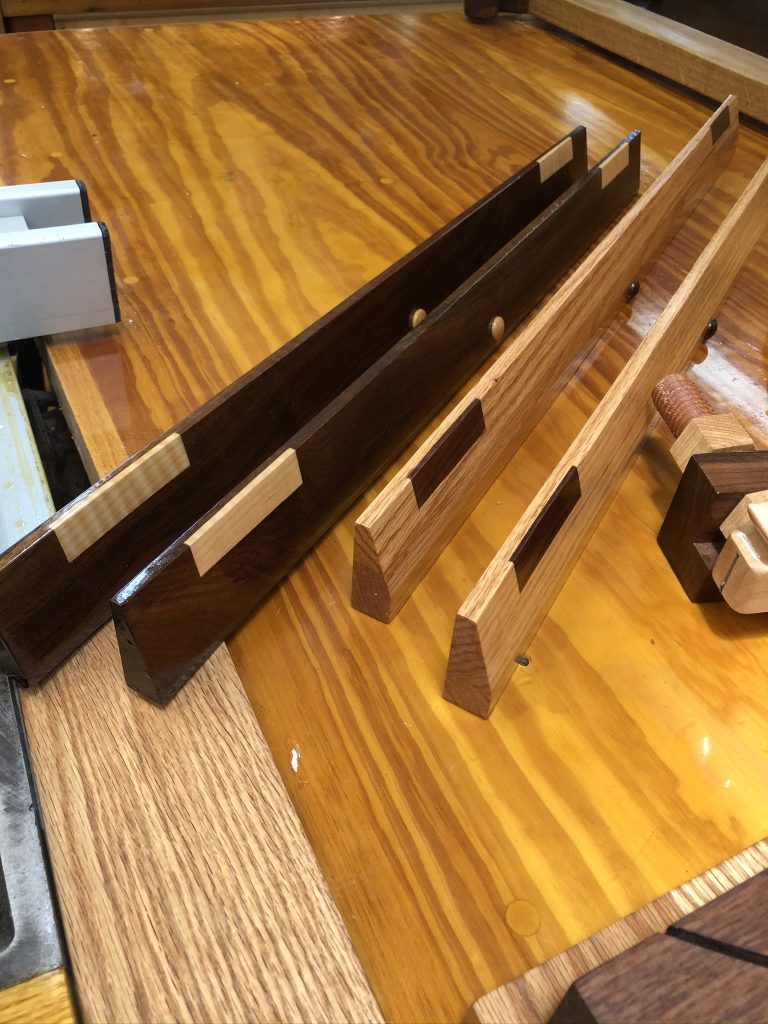
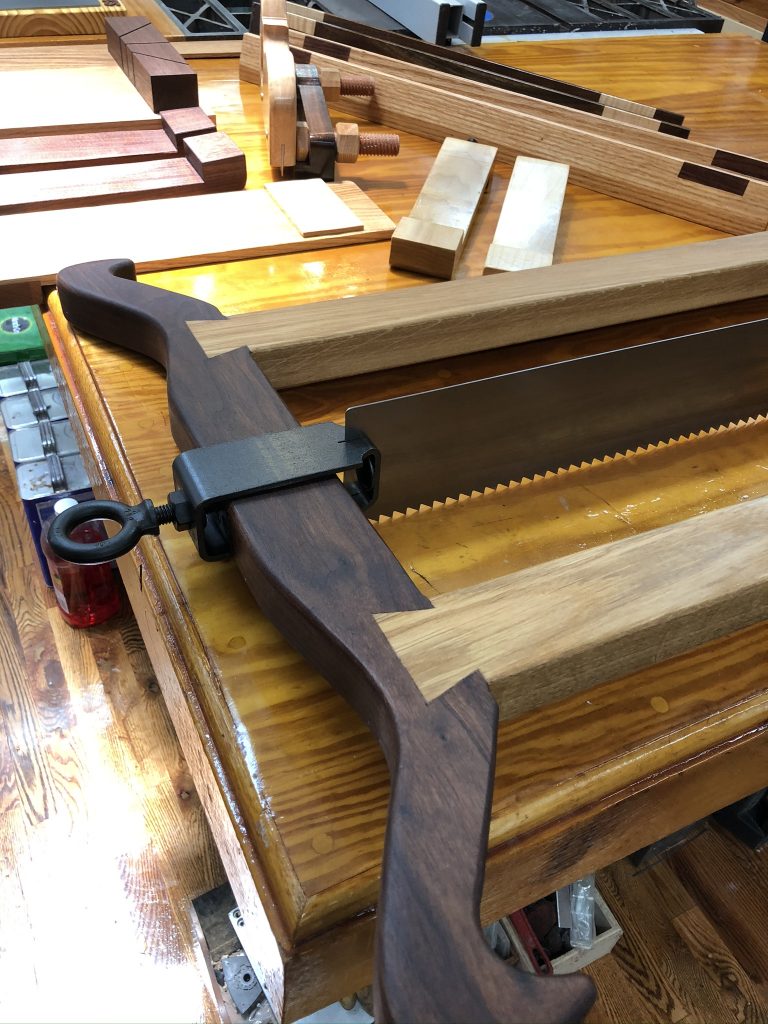
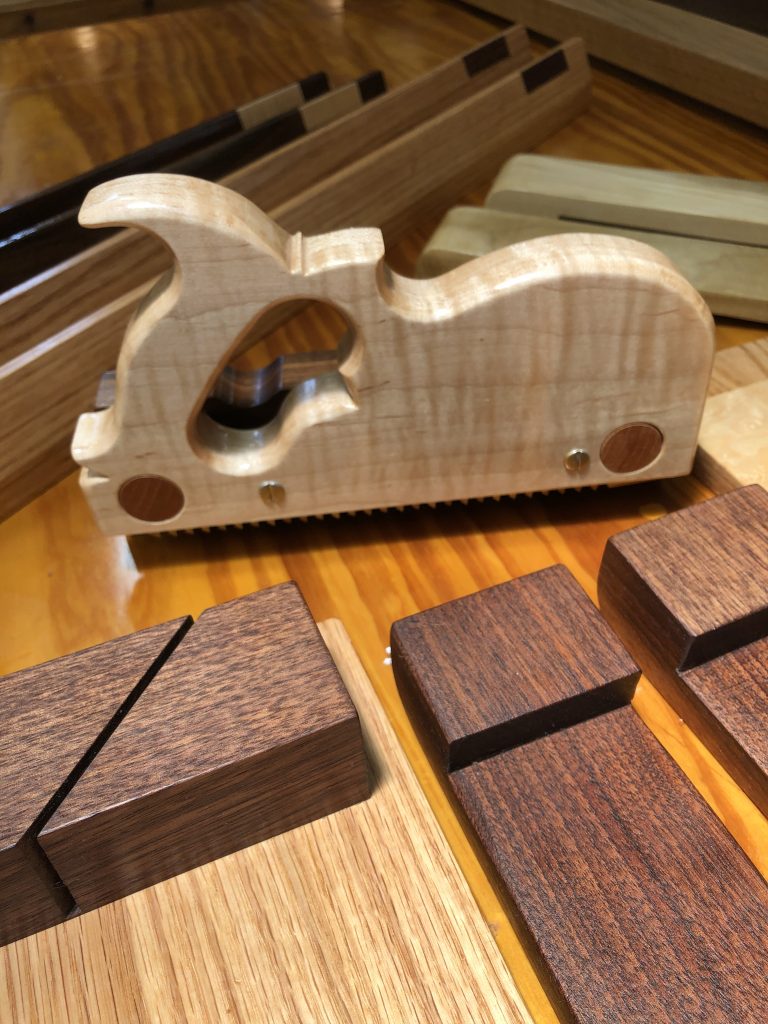
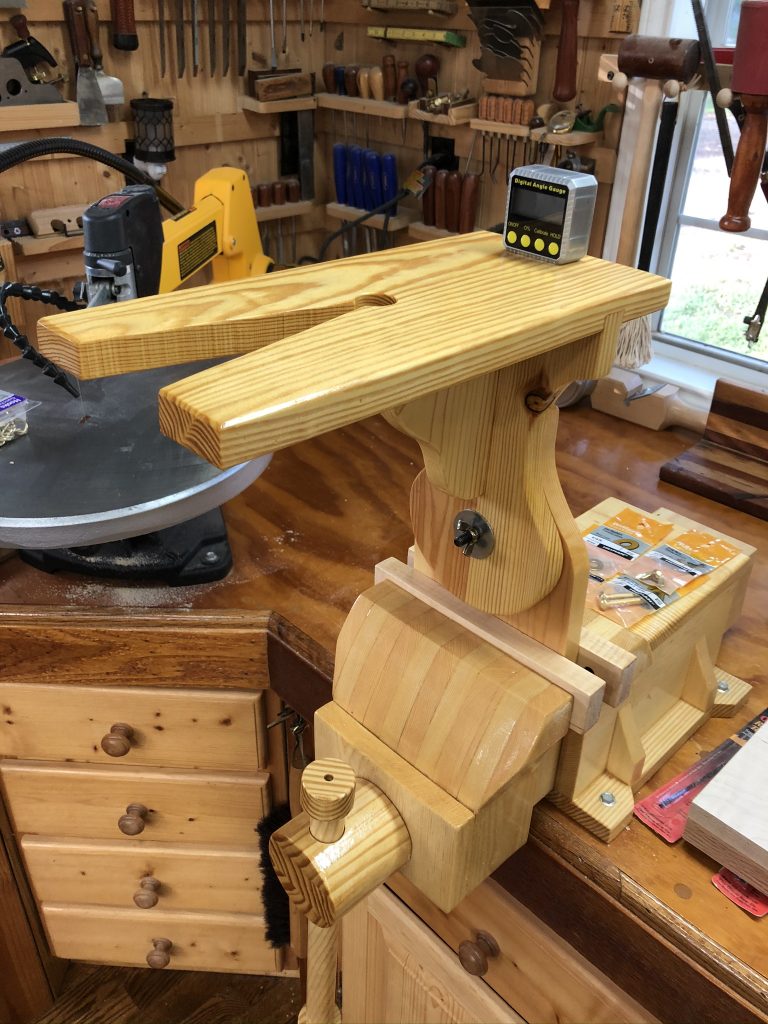
Question #20
Tobias: What is the next piece you are going to build and why?
John: There is more than one! I watch what other traditional woodworkers commonly build and what was once found in earlier shops, so the ideas are plenty…
I would like to build a saw till, a hand plane till, and maybe a tool cabinet. Other smaller pieces would include a miter jack, a high vise to compliment either my Roubo or Shaker workbench and a finally, a Federal style table.
Regarding the Federal table, I am not into Federal style furniture at all. Sometimes, encouraged by previous successes, I challenge myself.
When a famous woodworker posts a recent work such as a Federal Pembroke breakfast table with all the trimmings, I try to investigate and learn how he built it. Then I think “I can do that” and I set off… If I only build one well or admirably, then than will be enough!
Tool Wishlist
I would love either a Rikon or Laguna ‘re-saw Bandsaw and a Powermatic 1 hp 719A Mortiser. My current bandsaw does not have a big enough mouth or height for resawing wide boards.
I also want a two burner knife maker’s forge (Majestic Forge) for making travisher blades.
Lumber Wishlist
- A large stash of Cuban mahogany!
- Bird’s Eye Maple
- Curly Maple
- Hard Maple
- Holly
- Boxwood
- East Indian Satinwood
- Basswood for carving
- Walnut
Makers with whom I would love to spend quality time
- Neil @ Brownswoodcraft on Instagram. I love this guy, he does phenomenal work and is a kindred spirit.
- Frank Strazza
- Steve Latta
- Garrett Hack
- Frank Klausz
- Mike Pekovich
It has been great fun interviewing John Willette and finding out a little more about what drives his wonderful woodworking energy.
We truly hope that John’s workshop, passion and perseverance is an inspiration to amateur woodworkers across the country.
Please remember, if you know of any woodworkers who are doing great work, yet are hiding away in their shops, please let us know at info@rarewoodsusa.com

i thoroughly enjoyed reading this. thanks Tobias and John.
It was a great pleasure to interview John for The Woodworker Sessions USA! His enthusiasm is extremely infectious! Thanks BHW.
Thank you for conducting this interview and sharing my Father’s story and vast experience in woodworking. I’m proud of the work he does and this was very informative. -David
Hi David. Compliments of the season to you and your dad. I enjoyed the interview with you father very much. Many thanks for your comment. Best regards, Tobias